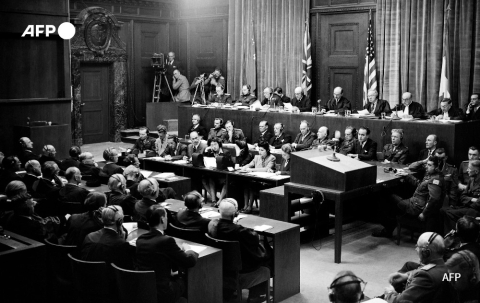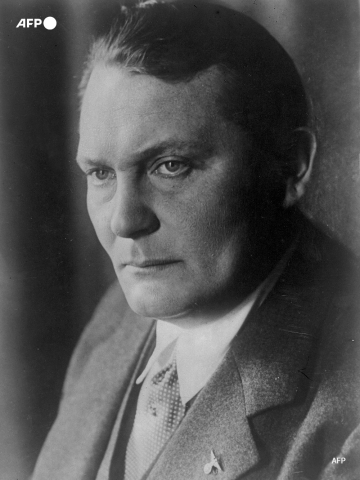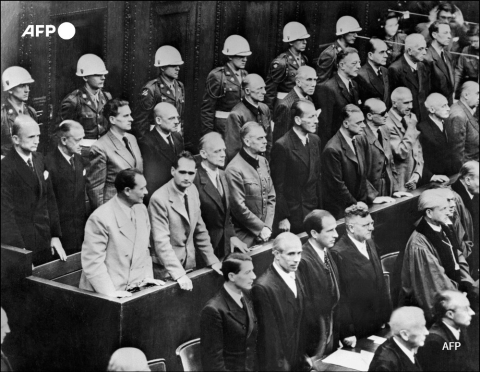November 20, 1945 : The Nuremberg trials open

By Bénédicte REY
On November 20, 1945, the first international trial in history opened in Nuremberg, Germany, forcing 21 senior Nazi officials to face justice before an international tribunal for the first time.
Adolf Hitler's designated successor Hermann Goering was one of the accused.
The Allies had prepared to punish German war criminals since 1943 and agreed to hold an unprecedented public trial once the Nazis were defeated.
Just six months after the fighting ended, prosecutors from four victorious nations had collected 300,000 witness statements and 6,600 pieces of evidence, laid out in a 42-volume archive.
The allied powers also named four judges, Francis Biddle from the United States, Geoffrey Lawrence from Great Britain who was also the chief judge, Henri Donnedieu de Vabres of France, and Soviet general Iona Nikitchenko.
Nuremberg, a former imperial German city now in ruins served as backdrop for the trial, its main courthouse and adjacent prison were fortunately still intact.
Nuremberg was also symbolic because it was there that Hitler staged massive rallies before the war and anti-Jewish laws were passed in 1935.
On November 20, 1945 at 10:00 a.m., Lawrence addressed the audience in courtroom 600, declaring: "This trial, which is now to begin, is unique in the annals of jurisprudence."
In his memorable opening statement, US prosecutor Robert Jackson told the tribunal: "The real complaining party at your bar is Civilization."
In the dock sat many of the highest-ranking Nazi officials, aside from Hitler, Joseph Goebbels and Heinrich Himmler, all of whom had committed suicide.

Goering, the regime's second most powerful figure, sat near Hitler aid Rudolf Hess, Nazi ideologist Alfred Rosenberg, Fritz Sauckel who had organised forced labour, former foreign minister Joachim von Ribbentrop, and many others.
Eight criminal organisations, including the Gestapo secret police and paramilitary group Schutzstaffel (SS) were also named as defendants.
The charges included crimes against peace, war crimes, and for the first time in history, crimes against humanity.
All of the accused pleaded "nicht schuldig," or not guilty.
The proceedings were swiftly marked by a film produced by the western Allies in liberated concentration camps.
On October 1, 1946 after hearings that lasted 218 days, the sentences were read out. Twelve of the men were condemned to death, including one in abstentia, Hitler's personal secretary Martin Bormann.
Unbeknown to the court, Bormann was already dead.
Three defendants were sentenced to life in prison, two to 20-year terms and one each to 15 and 10 years behind bars.
Three of those accused were set free, which surprised observers at the time but which served to reinforce the court's reputation for impartiality.

The Nuremberg trials did not escape all criticism however, in particular that of simply being another case of victors' justice.
The proceedings also turned a blind eye to possible Soviet crimes, notably the Katyn massacre that Soviet prosecutors blamed on the Nazis.
A Nazi-Soviet pact agreed upon early in World War II also went unmentioned.
On October 16, 1946 at 1:00 a.m., 10 of those sentenced to death were hanged. Goering had killed himself a few hours earlier by swallowing cyanide to escape what he considered a humiliating end for a soldier.
All of the bodies were cremated and the ashes dumped into a tributary of the Isar river to prevent their graves becoming gathering places for Nazi sympathisers.
Nuremberg later hosted 12 more trials, of Nazi doctors, ministers and military chiefs, and a similar tribunal was established in Tokyo in 1946 to try Japanese war criminals.
The courts raised hopes for the creation of an international code of justice, but it was not until 1993 and the International Criminal Tribunal for the Former Yugoslavia that a sovereign nation's leaders stood trial again for crimes against humanity.
The International Criminal Court (ICC), which owes much to the Nuremberg tribunal, was created in 2002.
